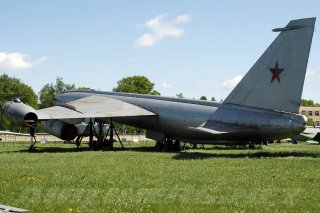This Old Russian Jet Bomber Terrified the U.S. Military
Believing that the Soviet Union was rapidly manufacturing a fast bomber with the range to hit the United States, the so-called “Bomber Gap” theory drove American defense spending for several years and resulted in a buildup of American airpower, particularly long-range strategic bombers.
Here's What You Need To Remember: The United States was caught off guard—they had no knowledge of a Soviet jet-powered bomber project, let alone the fact that Soviet jet bombers were now in production.
Following the Second World War, the Soviet Union was dependent on their Tupolev Tu-4, a copy of the American B-29 Superfortress long-range turboprop bomber. While both the American Superfortress and the USSR’s reverse-engineered copy were decently capable when they first went into production, both bombers became increasingly vulnerable to much faster and more maneuverable jet fighters.
Unlike the American or Royal Air Force, the Soviet Union did not have a jet-powered bomber in service. Furthermore, American airplanes based in Europe could strike the USSR with very little warning, whereas the turboprop Tu-4 lacked the necessary range to hit targets in the United States and return to the Soviet Union, leaving the Soviet Union’s Long-Range Aviation branch at a distinct disadvantage. To catch up to the United States, the Soviet Union turned to the Myasishchev Design Bureau and tasked them with building a jet bomber that could hit targets in Europe and the United States—the Myasishchev M-4.
Myasishchev M-4
On paper, Myasishchev’s design was impressive. The strategic bomber had four turbojet engines mounted side by side in the wing roots that could propel the bomber to high subsonic speeds—several hundred miles per hour faster than the preceding Tu-4. Six 23mm cannons mounted in twin turrets at the tail and both top and bottom of the aircraft’s fuselage provided defensive protection from enemy interceptors. Later improvements to the design focused on increasing its range by incorporating more fuel-efficient engines and a nose-mounted refueling probe.
Bomber Gap
The Myasishchev jet bomber caused quite a scare in the American intelligence community. The M-4 made its public debut during the Soviet Union’s annual May Day parade in 1954. The United States was caught off guard—they had no knowledge of a Soviet jet-powered bomber project, let alone the fact that Soviet jet bombers were now in production. At an air show the following year, additional M-4 airframes were seen, cementing the belief that the M-4 was being mass produced.
Believing that the Soviet Union was rapidly manufacturing a fast bomber with the range to hit the United States, the so-called “Bomber Gap” theory drove American defense spending for several years and resulted in a buildup of American air power, particularly long-range strategic bombers.
Postscript
Despite initial intelligence that seemed to affirm the M-4’s enormous production numbers, subsequent flyovers over the Soviet Union by American and British pilots in the late 1950s revealed that the Soviet Union hadn’t built up the production infrastructure to manufacture M-4s in the numbers that were initially believed.
Despite the improvements to the airframe, the Myasishchev M-4’s capabilities were never increased enough to give it the range to hit targets of strategic value in the United States and return to the Soviet Union. Production ceased in the early 1960s. Though most of the M-4s were eventually broken up for scrap, several of them served as tanker aircraft until the mid-1990s. A modified M-4 also served as an outsize cargo transport for the Soviet Union’s Buran space shuttle program.
Caleb Larson is a Defense Writer with The National Interest. He holds a Master of Public Policy and covers U.S. and Russian security, European defense issues, and German politics and culture.
This article first appeared last year and is being reprinted due to reader interest.

